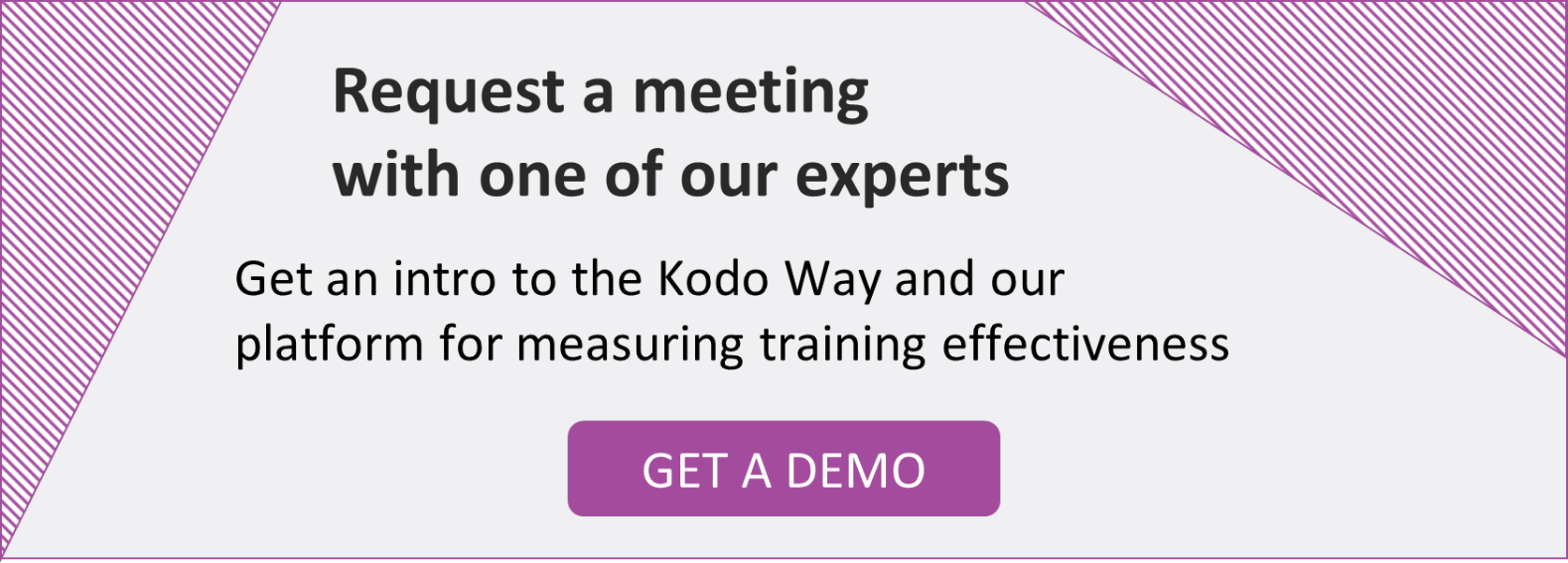
If you’ve heard of the Brinkerhoff Model and want to know more, this is the post for you. This week, we’re covering Brinkerhoff’s Success Case Method (SCM) and giving you a complete guide to its methodology and goals. Here at Kodo Survey, we’re keen to cover as many learning evaluation models as possible, and the Brinkerhoff Model certainty deserves a closer look.
In this Brinkerhoff Model 101 guide, we’ll explain everything you need to know about Brinkerhoff’s model, including what it is, how you apply it and how to understand its methodology and goals.
We’ll be discussing things like:
- What is the Brinkerhoff Model?
- What is the Success Case Method?
- Understanding the Methodology of the Success Case Method
- Goals of the Success Case Method
- Key features of the Brinkerhoff Model
- Examples of Success Case Method Methodology and Goals
- Conclusion
1. What is the Brinkerhoff Model?
In 2003, Robert O. Brinkerhoff introduced an entirely new way of evaluating training effectiveness. He called it the Success Case Method (SCM) and it quickly gained traction in a useful way of assessing the impact of training, coaching and other organizational interventions.
The SCM, however, isn’t limited to this context and can provide a useful approach for documenting the factors that can affect, enhance or impede a variety of situations or events. As the SCM primarily focuses on qualitative analysis, it can be used to analyze any major business change, such as the implementation of a new process or even the purchase of new equipment.
When Brinkerhoff published an article about his Success Case Method in 2005, he stated that traditional evaluation models and methods were wrong to focus on simply “assessing the scope of training’s effect”. He argued that performance was the key factor behind achieving (or not achieving) results. While other training evaluation models focus more on effective human resource development (HRD) operations, Brinkerhoff’s SCM aims to “inquire more broadly into the performance management context.”
2. What is the Success Case Method?
The SCM is a methodology for understanding how a training or coaching program works well, or why it is not working. Unlike other training evaluation models (such as the Kirkpatrick Model) SCM isn’t concerned with finding the average performance of training participants. Instead, it deliberately studies the most successful participants and the least successful ones. In other words, it looks at the extreme cases.
The two most important questions asked by the SCM are:
-
“How well does a program work in a best-case scenario?”
-
“When a program doesn’t work, what’s the reason for this?”
According to Brinkerhoff, an SCM study can be used to answer one or all of the following questions:
-
What is really happening?
-
What results, if any, is the program helping to produce?
-
What is the value of the results?
-
How could the initiative be improved?
(Brinkerhoff, 2003)
The SCM involves studying the impact of a training or coaching session and documenting all the factors that enhanced or impeded business impact. The end result is a study that is disseminated to an organization’s stakeholders to help their knowledge of the training and its impact on the business.

3. Understanding the Methodology of the Success Case Method
In 2003, Brinkerhoff outlined the main methodology of an SCM study. He identified five key steps that any organization should go through when applying the SCM to a particular training or coaching event.
The five steps of the SCM are:
-
Planning a Success Case study.
-
Defining what success should look like and drafting an “Impact Model”.
-
Writing a survey that identifies best-case and worst-case scenarios, then implementing this survey.
-
Documenting success cases and conducting interviews.
-
Drawing conclusions, writing recommendations and communicating findings to stakeholders.
4. Goals of the Success Case Method
The ultimate goal of the SCM is to examine the performance of the ‘outlier’ participants of any given training or coaching program and learn what to change to make it more successful. Brinkerhoff developed his model from the understanding that while some training programs are successful, and some are total flops, the vast majority fall somewhere in between. There will always be some participants who perform exceptionally well and others for whom the training didn’t work. These participants – the outliers – are the focus of the SCM approach. The goal is to identify and interview these participants and then compare the differences between them.
To deepen our understanding of the SCM, we can break down this goal into smaller sub-goals, as follows:
-
Identify what success looks like
-
Use surveys to identify the most and least successful participants
-
Study these participants in detail
-
Compare the successes to failures
-
Make recommendations for what to change in the future
-
Write and publicize success stories to show the value of the program
5. Key features of the Brinkerhoff Model
For anyone concerned with designing learning experiences, the Brinkerhoff Model offers several key features that should be of interest. Brinkerhoff’s SCM is a worthy alternative to other training evaluation models such as the Kirkpatrick’s model and Kaufman’s five levels of evaluation. In this section, we’ll explore some key features of Brinkerhoff’s approach and explain how it helps organizations creating learning experiences that improve their overall performance.
The key features of the Brinkerhoff Model are:
-
Focus on performance
-
Focus on systems
-
Focus on improvements
We’ll look at each of these areas in greater detail.
Focus on performance
The most important feature of Brinkerhoff’s model is that the focus is on collecting performance data. This makes it far more manageable than other training evaluation models such as Kirkpatrick that try to examine the broad scope of a training’s impact. Whereas as other evaluation models look closely at human resource development (HRD) operations, Brinkerhoff’s model is much more focused on pure performance of the participants. It wants to find the best and worst performers and find out what worked or what went wrong. This makes it far simpler to implement and much more do-able.
Focus on systems
One of the central criticism of the Kirkpatricks model is that it doesn’t measure the myriad of other factors besides training that can produce results. Brinkerhoff wrote that as training alone cannot produce results, “training should not be the object of evaluation” (Brinkerhoff, 2005). Brinkerhoff designed his SCM to focus squarely on systems because he recognized that multiple factors can impact the outcome of a learning opportunity, such as performance support, training, or resources. Therefore, multiple stakeholders – not just the training provider – are responsible for the results, from the employees all the way up to the senior executives.
In the SCM, the evaluation focuses on the following questions:
-
How well is an organization using learning to improve performance?
-
What organizational processes/resources are in place to support performance improvement? What needs to be improved?
-
What organizational barriers stand in the way of performance improvement?
(Brinkerhoff, 2005)
Focus on improvements
The third key feature of SCM is that it focuses on continuous improvement of both the training and the organization. It uses clear, purposeful sampling and collects data that other training evaluation models may miss if they only look at averages. By deliberately searching for the outlier participants, the SCM flags up emerging success factors that an organization may not have included in their impact model. These unexpected business results can be communicated in the reporting stage.
6. Example Success Case Method Goals and Methodology
Now that we’ve looked at what the SCM is and how it works, we can look at an example of SCM goals and methodology. As we’ve seen, the SCM approach has much in common with an inquiry and case study, yet it also uses storytelling to help explain the key finding to the stakeholders of a particular organization.
When you apply the SCM, your main goals are to find:
-
Which participants (or groups of participants) were most successful in applying a learning opportunity and why?
-
Which participants were least successful and why?
Ultimately, your goal is to interview and analyze these two outlying groups of participants and identify ways that a training or coaching course could be improved for the benefit of the organization.
When it comes to methodology, there are a number of steps involved in applying SCM.
Step 1. Develop an impact model
The first step is to identify the goals of the training and determine how they should impact business performance. For instance, a widget factory implementing a training program for a new machine would define success as having all employees fully trained on how to use the machine. A successful outcome would be having production rise, leading to greater efficiency and profits. Once success has been defined, the organization can write an impact model.
Step 2: Identify the best and worst cases
The second stage is to design and write survey questions that help identify the best-case and worst-case outcomes among course participants. For example, you may ask employees: “Have you applied what you learned in your day-to-day work?”. For manual tasks, such as operating a machine, you may set a performance task instead. This will help you identify participants for whom the training worked well and those for whom the training was unsuccessful.
Step 3: Obtain evidence
The third stage of applying SCM is to study the outlier participants in greater detail. You may conduct interviews, review documents or use other methods that help you build a fuller picture of what went right or what went wrong. The goal is to gain a full understanding of why the training was successful or unsuccessful.
Step 4. Analyze the data
At this stage, you may uncover evidence or facts that weren’t considered in earlier stages. For example, what if a training course that taught employees how to use a certain machine was effective, but the machine was unreliable during daily operations? What if an employee missed part of training? In other words, there may be other factors as to why one participant did well and why another performed poorly.
Step 5. Communicate findings and make recommendations
The final step of implementing SCM is to share your findings with an organization’s stakeholders. Your goal is to highlight areas where the training was a resounding success and also to identify ways that it could be improved in the future. This final stage should focus on continuous process improvement and the emphasis should be on finding ways to improve not only the training but the business outcomes too.
One of the most helpful ways to present findings is through the use of case stories. You can choose one or a group of employees who did well on a particular training course and write about them. This provides a meaningful way to involve stakeholders and show them how the training helped improve certain aspects of the organization. Case stories can help build meaningful dialogue between the training providers, the employees and the stakeholders about how to continually improve business outcomes.
7. Conclusion
Overall, Brinkerhoff’s SCM provides an extremely useful, flexible way of working out why or why not a training or coaching program was successful. In its favor, SCM is certainly easier and more cost-effective to apply that other learning evaluation methods such as the Kirkpatrick Model. SCM helps you learn lessons about your employees’ successes as well as their failures and apply these lessons to your future business and training endeavors. If you're ready to find out how Kodo Survey can help you evaluate the effectiveness of your training programs and learning journeys, request a demo with one of our experts today.
Related Posts

